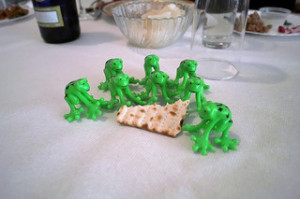Some people want to have a very fast seder. This guide is for them.
A few years ago a friend asked if I could put together a five minute seder.
Pass it on to anyone for whom it might be helpful.
If you want a more detailed explanation, download The Beyond BT Guide to the Seder.

1) Kaddesh – Sanctify the day with the recitation of Kiddush
*Leader says
On Shabbos add:
Vay’hi erev vay’hi voker yom hashi-shi. Vay’chulu hashamayim v’ha-aretz v’choltzva’am.
Vay’chal Elohim bayom hashvi’i, m’lachto asher asah, vayishbot bayom hashvi-i,
mikol-mlachto asher asah. Vay’vareich Elohim, et-yom hashvi’i, vay’kadeish oto,
ki vo shavat mikol-mlachto, asher-bara Elohim la-asot.
On all days continue
Boruch Atoh Ado-noy Elo-haynu Melech Ho-olom Boray P’ri Ha-Gofen.
Baruch atah Adonai, Eloheinu melech ha’olam, asher bachar banu mikol’am,
v’rom’manu mikol-lashon, v’kid’shanu b’mitzvotav, vatiten-lanu Adonai Eloheinu
b’ahavah (shabatot limnuchah u) moadim l’simchah, chagim uz’manim l’sason et-yom
(hashabat hazeh v’et-yom) chag hamatzot hazeh. Z’man cheiruteinu, (b’ahavah,)
mikra kodesh, zeicher litziat mitzrayim. Ki vanu vacharta v’otanu kidashta mikol
ha’amim. (v’shabat) umo’adei kod’shecha (b’ahavah uv’ratzon) b’simchah uv’sason
hinchaltanu. Baruch atah Adonai, m’kadeish (h’shabbat v’) Yisrael v’hazmanim.
Ba-ruch A-tah A-do-noi E-loi-hei-nu Me-lech ha-o-lam
she-he-chee-ya-nu v’ki-yi-ma-nu vi-hi-gi-ya-nu liz-man ha-zeh.
*Drink the 1st cup of wine. Lean to your left while drinking.
2) Urechatz, – *Wash your hands before eating Karpas.
3) Karpas – *Eat a vegetable dipped in salt water.
*Leader says Boruch Atoh Ado-noy Elo-haynu Melech Ho-olom Boray P’ri Ho-adomah –
*Everybody eats the vegetable. Lean to your left while eating.
4) Yachatz. -* Break the middle Matzah. Hide the larger half for Afikoman.
5) Maggid – *Tell the story of the Exodus from Egypt
Here is a summary of the story. (Alternatively go around the room reading in English from a translated Haggadah.)
The main mitzvah of the night is telling about the Exodus from Egypt.
*Pour the 2nd Cup of Wine
*Four Questions are asked
*The answer to the four questions is given.
According to one commentator, it’s broken up into 6 parts based on the verse in the Torah which describes the mitzvah of telling the story at the Seder:
“And you shall relate to your child on that day saying: it is because of this Hashem acted for me when I came forth out of Egypt.”
a)– And you shall relate to your child – four types of chidren/people with different belief levels are discussed.
b)– on that day – explains that we should tell the story on Passover night and not earlier in the month,
c)– saying – the actual story:
Our ancestors were idol worshippers;—– through Abraham;—– Egyptian Enslavement;—– We cry out;—– G-d hears our cries
G-d saves us with the 10 plagues;—– We express our thanks for G-d saving us
Dip your finger in the wine for the 10 plagues
1) Water, which turned to blood and killed all fish and other aquatic life
2) Frogs
3) Lice
4) Wild animals
5) Disease on livestock
6) Incurable boils
7) Hail and thunder
8) Locusts
9) Darkness
10) Death of the first-born of all Egyptian humans and animals. To be saved, the Israelites had to place the blood of a lamb on the front door of their houses.
d) — It is because of this — “Rabban Gamliel explains why we use the Passover offering, Matzah and Maror.
The Passover lamb, represented in our times by the roasted bone, recalls the blood on the doorposts and the terror and anticipation of the night of the plague of the first born.
Matzah is what we ate in the morning when Israel was rushed out of Egypt with no time to let their dough rise.
Maror captures the bitterness of the enslavement.
e) — Hashem acted for me…†– “In every generation, we should see ourselves as if we had gone out from Egypt.
f) – when I came forth out of Egypt.†–We recite 2 songs of praise to G-d similar to the songs recited when we left Egypt.
*Leader of Seder recites Boruch Atoh Ado-noy Elo-haynu Melech Ho-olom Boray P’ri Ha-Gofen.
*Drink the 2nd cup of wine. Lean to your left while drinking.
6) Rachtzah – *Wash the hands prior to eating Matzah and the meal.
*After washing and before drying say
*Say Boruch Atoh Ado-noy Elo-haynu Melcch Ho-olom Asher Kidshonu B’mitzvosov V’tzivonu Al N’tilas Yodoyim.
7) Motzi – *Recite the Hamotzi blessing over eating Matzah before a Meal
*Say Boruch Atoh Ado-noy Elo-haynu Melech Hamotzi Lechem Min Ho-oretz.
8) Matzah – *Recite the blessing over eating Matzah
*Say Boruch Atoh Ado-noy Elo-haynu Melech Ho-olom Asher Kidshonu B’mitzvosov Vtzivonu Al Achilas Matzah.
*Eat the Matzah. Lean to your left while eating.
9) Maror – *The Maror is dipped in Charoscs
*Say Boruch Atoh Ado-noy Elo-haynu Melech Ho-olom Asher Kidshonu B’mitzvosov Vtzivonu Al Achilas Maror.
*Eat the Maror.
10) Korech – *Eat a sandwich of Matzah and Maror.
*Eat the Sandwich.
11) Shulchan Orech – *Eat the festival meal
Find the Afikoman.
12) Tzafun – *Eat the Afikoman which had been hidden all during the Seder.
*Pour the 3rd cup of wine
13) Barech – Recite Birchas Hamazon, the blessings after the meal
*Leader of Seder recites blessing Boruch Atoh Ado-noy Elo-haynu Melech Ho-olom Boray P’ri Ha-Gofen.
*Drink the 3rd cup of wine. Lean to your left while drinking.
*Pour the 4th cup of wine;
*Pour the cup for Elijah
14) Hallel – Recite the praises of G-d
*Leader of Seder recites Boruch Atoh Ado-noy Elo-haynu Melech Ho-olom Boray P’ri Ha-Gofen.
*Drink the 4th cup of wine. Lean to your left while drinking.
15) Nirtzah – Pray that G-d accepts our praise and speedily sends the Messiah.
Sing the songs of the Haggadah
photo credit: dcJohn via photopin cc

